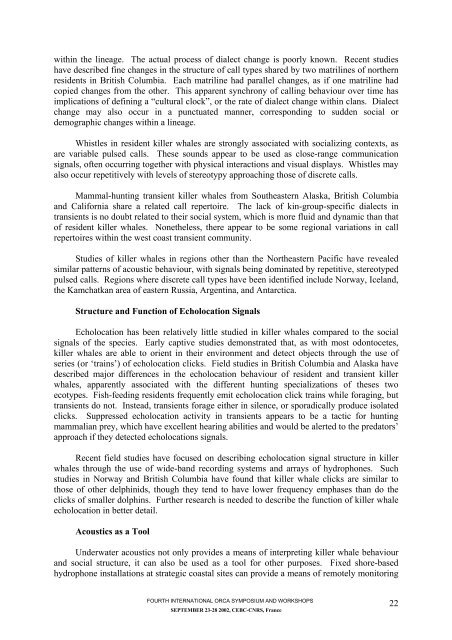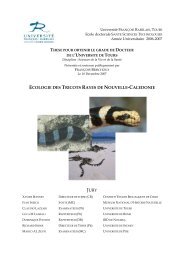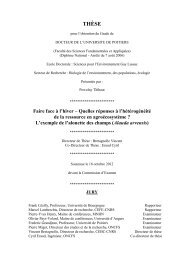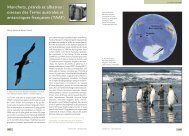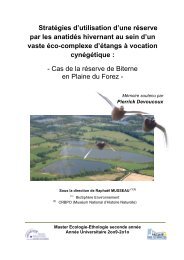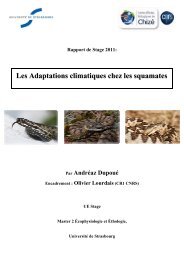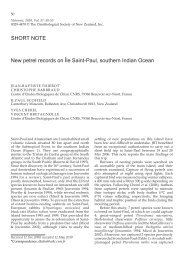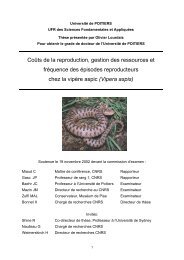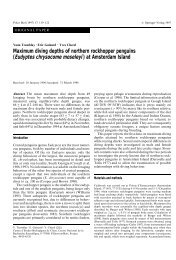Fourth International Orca Symposium and Workshop - CEBC - CNRS
Fourth International Orca Symposium and Workshop - CEBC - CNRS
Fourth International Orca Symposium and Workshop - CEBC - CNRS
You also want an ePaper? Increase the reach of your titles
YUMPU automatically turns print PDFs into web optimized ePapers that Google loves.
within the lineage. The actual process of dialect change is poorly known. Recent studies<br />
have described fine changes in the structure of call types shared by two matrilines of northern<br />
residents in British Columbia. Each matriline had parallel changes, as if one matriline had<br />
copied changes from the other. This apparent synchrony of calling behaviour over time has<br />
implications of defining a “cultural clock”, or the rate of dialect change within clans. Dialect<br />
change may also occur in a punctuated manner, corresponding to sudden social or<br />
demographic changes within a lineage.<br />
Whistles in resident killer whales are strongly associated with socializing contexts, as<br />
are variable pulsed calls. These sounds appear to be used as close-range communication<br />
signals, often occurring together with physical interactions <strong>and</strong> visual displays. Whistles may<br />
also occur repetitively with levels of stereotypy approaching those of discrete calls.<br />
Mammal-hunting transient killer whales from Southeastern Alaska, British Columbia<br />
<strong>and</strong> California share a related call repertoire. The lack of kin-group-specific dialects in<br />
transients is no doubt related to their social system, which is more fluid <strong>and</strong> dynamic than that<br />
of resident killer whales. Nonetheless, there appear to be some regional variations in call<br />
repertoires within the west coast transient community.<br />
Studies of killer whales in regions other than the Northeastern Pacific have revealed<br />
similar patterns of acoustic behaviour, with signals being dominated by repetitive, stereotyped<br />
pulsed calls. Regions where discrete call types have been identified include Norway, Icel<strong>and</strong>,<br />
the Kamchatkan area of eastern Russia, Argentina, <strong>and</strong> Antarctica.<br />
Structure <strong>and</strong> Function of Echolocation Signals<br />
Echolocation has been relatively little studied in killer whales compared to the social<br />
signals of the species. Early captive studies demonstrated that, as with most odontocetes,<br />
killer whales are able to orient in their environment <strong>and</strong> detect objects through the use of<br />
series (or ‘trains’) of echolocation clicks. Field studies in British Columbia <strong>and</strong> Alaska have<br />
described major differences in the echolocation behaviour of resident <strong>and</strong> transient killer<br />
whales, apparently associated with the different hunting specializations of theses two<br />
ecotypes. Fish-feeding residents frequently emit echolocation click trains while foraging, but<br />
transients do not. Instead, transients forage either in silence, or sporadically produce isolated<br />
clicks. Suppressed echolocation activity in transients appears to be a tactic for hunting<br />
mammalian prey, which have excellent hearing abilities <strong>and</strong> would be alerted to the predators’<br />
approach if they detected echolocations signals.<br />
Recent field studies have focused on describing echolocation signal structure in killer<br />
whales through the use of wide-b<strong>and</strong> recording systems <strong>and</strong> arrays of hydrophones. Such<br />
studies in Norway <strong>and</strong> British Columbia have found that killer whale clicks are similar to<br />
those of other delphinids, though they tend to have lower frequency emphases than do the<br />
clicks of smaller dolphins. Further research is needed to describe the function of killer whale<br />
echolocation in better detail.<br />
Acoustics as a Tool<br />
Underwater acoustics not only provides a means of interpreting killer whale behaviour<br />
<strong>and</strong> social structure, it can also be used as a tool for other purposes. Fixed shore-based<br />
hydrophone installations at strategic coastal sites can provide a means of remotely monitoring<br />
FOURTH INTERNATIONAL ORCA SYMPOSIUM AND WORKSHOPS<br />
SEPTEMBER 23-28 2002, <strong>CEBC</strong>-<strong>CNRS</strong>, France<br />
22


